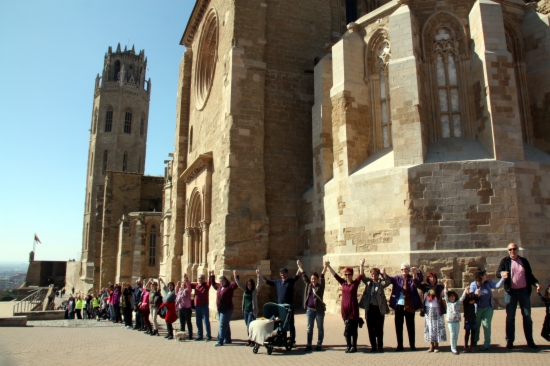Joining hands to name Lleida's 13th century cathedral UNESCO World Heritage
Some 250 people have joined hands around the old Cathedral of Lleida (Western Catalonia) for the third consecutive year, urging the monument and its surroundings to be declared UNESCO World Heritage Site. In the heart of the Catalan city, the tremendous ‘Turó de la Seu Vella’, literally the Hill of the Old See, is formed of several buildings, with the most significant being the 13th century cathedral, known as ‘La Seu Vella’. The hill also hosts the remains of La Suda or King's Castle (Castell del Rei o La Suda), well preserved military fortifications built from the 14th to the 18th century and other archaeological gems. An official nomination bid was eventually presented this January, setting up the first stage of a lengthy procedure.

Lleida (ACN).- Some 250 people joined hands around the old Cathedral of Lleida (Western Catalonia) in a symbolic embrace, urging the UNESCO to declare the building and its surroundings World Heritage Site. In the heart of the Catalan city, the tremendous ‘Turó de la Seu Vella’, literally the Hill of the Old See, is formed of several buildings, with the most significant being the Romanesque cathedral, known as ‘La Seu Vella’ and dating back from the 13th century. The hill also hosts the remains of La Suda or King's Castle (Castell del Rei o La Suda), well preserved military fortifications built from the 14th to the 18th century, as well as archaeological gems. It is the third consecutive year a human chain is organised around the old Cathedral to have the site declared UNESCO World Heritage. An official nomination bid was eventually presented this January and addressed to the Catalan Minister of Culture, Ferran Mascarell, who described it as “a magnificent application” which would enable to face a lengthy “procedure with the conviction that it will be a winning one”.
Last Sunday’s human chain was organised by Dona Balàfia – an NGO defending women's rights – for the third consecutive year, with the support of other organizations in Lleida. Once again, it was set on the International Day of Women and the participants have also used the opportunity to defend gender equality, hanging a large hand-made tapestry banner to this effect. Despite the high attendance, the symbolic embrace did not circle the entire cathedral, which will be one of the objectives to be achieved during next year’s event.
The nomination bid underlined Lleida’s preservation policies
In late January, a bid for nomination was publicly presented in Lleida, drafted by members of Lleida’s City Council and the Catalan Ministry of Culture with the participation of representatives of UNESCO Catalonia. The document, entitled 'El Turó de la Seu Vella: Paisatge de memòria, fita monumental i buit urbà' ('La Seu Vella Hill: Landscape of Memory, monumental landmark and urban void') was divided into six volumes, defending the ancient hill’s universal and historic value. The nomination bid also compared the buildings with other monuments declared World Heritage Sites, and included photos taken after the renovation works of 1992-1993, the ‘Turó Special Plan’ implemented in 1994-1995 and the Plan regarding Lleida’s Historical Centre. In the coming months, further contributions may be included in the bid.
The historical site played an active part “in the whole of Europe and in the world”
During the presentation of the document, the Mayor of Lleida, Àngel Ros described the ensemble of buildings as some “of the great works of the transition from Romanesque to Catalan Gothic architecture”. He also stressed the historical value and “contribution of the Turó de la Seu Vella in the whole of Europe and in the world”. Such influence “was reflected from Baix Segre [area surrounding Lleida] on Greece, through the tales of conquests by the former Crown of Aragon, ordered from [Lleida’s] Castell del Rei”, explained Ros.
For his part, the Director of the Turó de la Seu Vella Consortium, Pep Tort, insisted that “there are not any other cloisters and towers like those of Seu Vella”. He also pointed out the significance, in current times, of “the idea of human, urban, and cultural landscape that holds memory”. According to him, such an idea is embodied by the Turó de la Seu Vella and therefore provides consistency to the nomination bid.
A lengthy and complex process
The nomination bid was the first step of a process that will be a “matter of years”, in the words of the Mayor of Lleida. In order for ‘Turó de la Seu Vella’ to be recognised as a UNESCO World Heritage, various obstacles will have to be overcome, first in Catalonia, then in Spain, and finally within the UNESCO itself. Thus, according to him, it will take at least 4 or 5 years and potentially up to 8 or 10 years for ‘Seu Vella’ to be declared a World Heritage Site.
In February, the document was first addressed to the Catalan Minister of Culture, Ferran Mascarell, who was convinced that the procedure “will be a winning one”. Nevertheless, the application has yet to be assessed by the Committee of the Department of Cultural Heritage in Catalonia, with the assistance of UNESCO representatives. If the ‘Turó de la Seu Vella’ bid is selected by the Catalan Committee, which will have to choose amongst a variety of applications issued by different towns and cities in Catalonia, it will be sent to the Spanish Ministry of Culture. Its members will decide whether to transfer the bid to the UNESCO, which will have the final say in the matter.